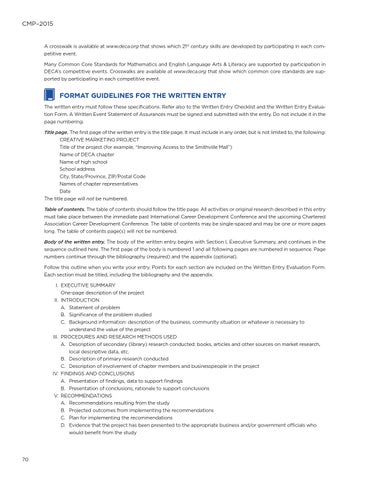CMP–2015
A crosswalk is available at www.deca.org that shows which 21st century skills are developed by participating in each competitive event. Many Common Core Standards for Mathematics and English Language Arts & Literacy are supported by participation in DECA’s competitive events. Crosswalks are available at www.deca.org that show which common core standards are supported by participating in each competitive event.
FORMAT GUIDELINES FOR THE WRITTEN ENTRY The written entry must follow these specifications. Refer also to the Written Entry Checklist and the Written Entry Evaluation Form. A Written Event Statement of Assurances must be signed and submitted with the entry. Do not include it in the page numbering. Title page. The first page of the written entry is the title page. It must include in any order, but is not limited to, the following: CREATIVE MARKETING PROJECT Title of the project (for example, “Improving Access to the Smithville Mall”) Name of DECA chapter Name of high school School address City, State/Province, ZIP/Postal Code Names of chapter representatives Date The title page will not be numbered. Table of contents. The table of contents should follow the title page. All activities or original research described in this entry must take place between the immediate past International Career Development Conference and the upcoming Chartered Association Career Development Conference. The table of contents may be single-spaced and may be one or more pages long. The table of contents page(s) will not be numbered. Body of the written entry. The body of the written entry begins with Section I, Executive Summary, and continues in the sequence outlined here. The first page of the body is numbered 1 and all following pages are numbered in sequence. Page numbers continue through the bibliography (required) and the appendix (optional). Follow this outline when you write your entry. Points for each section are included on the Written Entry Evaluation Form. Each section must be titled, including the bibliography and the appendix. I. EXECUTIVE SUMMARY One-page description of the project II. INTRODUCTION A. Statement of problem B. Significance of the problem studied C. Background information: description of the business, community situation or whatever is necessary to understand the value of the project III. PROCEDURES AND RESEARCH METHODS USED A. Description of secondary (library) research conducted: books, articles and other sources on market research, local descriptive data, etc. B. Description of primary research conducted C. Description of involvement of chapter members and businesspeople in the project IV. FINDINGS AND CONCLUSIONS A. Presentation of findings, data to support findings B. Presentation of conclusions, rationale to support conclusions V. RECOMMENDATIONS A. Recommendations resulting from the study B. Projected outcomes from implementing the recommendations C. Plan for implementing the recommendations D. Evidence that the project has been presented to the appropriate business and/or government officials who would benefit from the study
70
